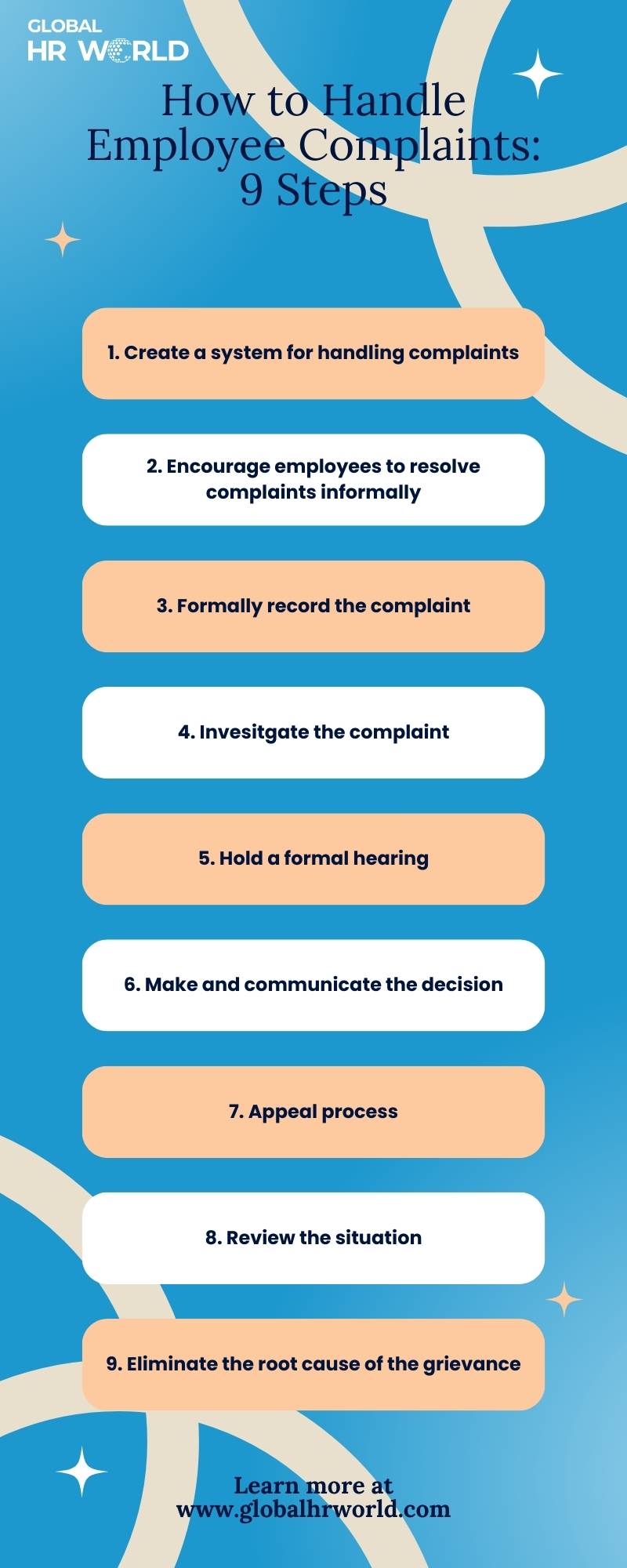In organizations, there are often instances where employees want to speak up about wrongdoings or unfair treatment that they or their colleagues are facing. Properly addressing these complaints is crucial for keeping employees happy, safe, and productive, as well as protecting the organizations from lawsuits and a bad reputation. Hence, businesses should have a structured system for taking in and responding to these complaints, so that they can promptly record, investigate and resolve all employee complaints that come their way. In this article, you will learn how to handle employee complaints so your business is always prepared to offer effective grievance redressal.
Types of Employee Complaints
Broadly speaking, every employee complaint is an instance of an employee speaking up about their dissatisfaction and negative experience with something at work. However, these complaints can be broken down into several different categories, based on the type of grievance the employee is coming to you with. Let us look at the different types of employee complaints you can expect to encounter:
Complaints About Discrimination and Harassment
These complaints arise when employees encounter unfair treatment based on factors that are part of their identity, such as race, sexuality, disability, gender, etc. Employees might receive offensive remarks, experience bullying, or be thwarted from equal opportunities within teams or departments as a result. Such treatment can lead to low self-esteem, mental health issues, and low morale, impacting the employee’s well-being and productivity.
Complaints About Unfair Treatment and Workload
Another type of complaint you can expect are those about unfair treatment and workload. These include issues such as employees receiving an overwhelming load of tasks, experiencing favoritism, or not getting recognition for their work and contribution.
Complaints About Compensation and Management
Compensation and management policies are another common area of dissatisfaction for employees. Employees might be dissatisfied with their compensation, performance evaluations, or the lack of proper explanations from managements’ side about crucial decisions.
Complaints About Working Conditions
Lastly, employees may have complaints about working conditions such as unsafe or unclean environments, long working hours, constant or uncompensated overtime, etc.
Out of these, complaints regarding discrimination, harassment, and unfair treatment tend to be the most common. The top three reasons for employee complaints are:
- Bullying or harassment (67%)
- Relationships with managers (54%)
- Relationships with colleagues (49%)
Hence, interpersonal problems are the most common issue employees face at the workplace. Such issues can be debilitating for the ones bearing their brunt, and can range from petty tiffs to severe misdemeanors. By establishing a clear procedure on how to handle employee complaints, businesses can safeguard themselves and their employees against the negative impact of workplace problems, leading to a happier and more productive workforce.
Steps on How to Handle Employee Complaints
Let us now jump into how to handle employee complaints. Employee complaints should be handled in a structured manner, where the proper steps are followed for each grievance. Being structured about addressing complaints ensures that you don’t miss out on important details about the issue you are trying to resolve, ensuring a fair and thorough resolution for all complaints.
Here is an outline of the procedure you can follow to handle employee complaints:
Create a System for Handling Complaints
First and foremost, you need to establish a system for handling complaints. This includes defining who will be responsible for the intake of complaints, what will be the procedure for taking complaints, and what other options employees will have to submit their complaints apart from walk-ins.
Encourage Employees to Resolve Complaints Informally
While setting up a system for handling complaints is necessary, it is recommended to also create an environment where employees can openly communicate and resolve their grievances without escalation.
Formally Record the Complaint
If the complaint cannot be resolved informally, your next step will be to formally record the complaint. Be sure to patiently and empathetically listen to the complaint and give them the space to express their grievance. Offer them multiple options for submitting their formal complaint and inform them of the complaint resolution process, including expected timeframes for each step.
Investigate the Complaint
Gather all the details that you can regarding the complaint. Confirm the validity of all the information provided to you by the complainant. This can be done by speaking to their supervisors and colleagues. In some cases, you will need to investigate as well as notify other parties involved. However, this isn’t always necessary.
Hold a Formal Hearing
This step is typically taken when the complaint is serious, making it optional for all other types of complaints. In a formal hearing, all involved parties are called on and given a chance to explain themselves as well as answer questions about the situation. Keep the hearing civil and focus on gaining as much factual information as possible, as well as validate the information you already have.
Making and Communicating a Decision
Once you have all the necessary information, you need to make and issue a formal decision on the complaint. You can fully or partially accept the complaint or fully reject it, depending on your findings. Be sure to be as prompt and quick with the decision as possible and explain your reasoning behind taking the decision clearly, citing organizational policies and protocol.
Appeal Process
After a formal decision has been issued, employees have the right to appeal if they are not satisfied with the resolution. To make an appeal, employees need to write a letter for the same. Then, a manager or supervisor who wasn’t previously involved in addressing the complains is assigned to listen to the complaint with fresh, impartial ears. After filing an appeal, an appeal hearing is conducted where another decision is delivered. However, if employees are still not satisfied with the resolution, they can escalate the complaint further.
Review the Situation
After delivering the final decision, review the situation to check if similar issues are not arising anymore. If the employee is happy with the resolution and there has been a change in policies and the behavior of your workforce, then it is safe to conclude that the complaint has been addressed and resolved justly.
Eliminate the Root Cause of the Grievance
Lastly, take measures to eliminate the root cause of the grievance altogether, to prevent similar situations from occurring in the future.
Infographic

Knowledge Check!
Frequently Asked Questions (FAQs)
How to handle an employee complaint?
Businesses should have a structured system for taking in and responding to these complaints, so that they can promptly record, investigate and resolve all employee complaints that come their way.
What are the 4 types of employee complaints?
The 4 types of complaints are:
Discrimination and harassment
Unfair treatment and workload
Compensation and management
Working conditions



